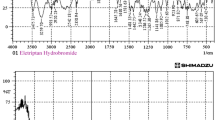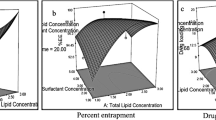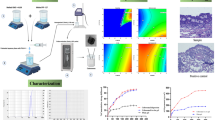Abstract
Migraine is the chronic neurological disorder identified by recurrent moderate to severe headache. Research was highlighted to formulate target drug delivery to treat migraine via the olfactory lobe through the intranasal route using ethosomal thermoreversible gel. Ethosomes were prepared by thin film hydration method using 32 factorial design. The prepared ethosomes were evaluated for percent drug loading, vesicle size, zeta potential, and polydispersity index, whereas nanoethosomal in situ gels were assessed for their pH, viscosity, mucoadhesive strength, and in vitro drug release. Ex vivo drug permeation was evaluated using nasal mucosa of sheep. The data produced from the experimental design indicated NE6 (soya lecithin 3%:ethanol 50%) as the optimized ethosome formulation, whereas NG3 (carbol 934-0.3%) and NG6 (PVP K30-0.3%) were recorded as the optimized in situ gel formulations. In vitro and ex vivo drug release demonstrated almost 100% release after 24 h for optimized formulations. In conclusion, drug-loaded in situ mucoadhesive gels could release the drug for longer duration of time which can improve the bioavailability providing new dimension to the treatment of migraine.










Similar content being viewed by others
Abbreviations
- NH:
-
Naratriptan hydrochloride
- NE6:
-
Optimized batch of ethosomes
- NG3:
-
Carbol 934-0.3%
- NG6:
-
PVP K30-0.3%
- PVP K30:
-
Polyvinylpyrrolidone K30
- 5-HT:
-
5-Hydroxytryptamine
- PBS:
-
Phosphate-buffered saline
- UV-vis:
-
Ultraviolet-visible spectroscopy
References
Abashzadeh, S., Dinarvand, R., Sharifzadeh, M., et al. (2011). Formulation and evaluation of an in situ gel forming system for controlled delivery of triptorelin acetate. European Journal of Pharmaceutical Sciences, 44, 514–521.
Agrawal, G., Wakte, P., & Shelke, S. (2017a). Formulation optimization of human insulin loaded microspheres for controlled oral delivery using response surface methodology. Endocrine, Metabolic & Immune Disorders Drug Targets, 17(2), 149–165.
Agrawal, G. R., Wakte, P., & Shelke, S. (2017b). Formulation, physicochemical characterization and in vitro evaluation of human insulin-loaded microspheres as potential oral carrier. ProgBiomat, 6(3), 125–136.
Andrews, G. P., Laverty, T. P., & Jones, D. S. (2009). Mucoadhesive polymeric platforms for controlled drug delivery. Journal of Pharmaceutics and Biopharmaceutics, 71, 505–518.
Bhalerao, A. V., Lonkar, S. L., Deshkar, S. S., et al. (2009). Nasal mucoadhesive in situ gel of ondansetron hydrochloride. Indian Journal of Pharmaceutical Sciences, 71, 711.
Bhandwalkar, M. J., & Avachat, A. M. (2013). Thermoreversible nasal in situ gel of venlafaxine hydrochloride: formulation, characterization, and pharmacodynamic evaluation. AAPS PharmSciTech, 14, 101–110.
Bhowmik, M., Kumari, P., Sarkar, G., et al. (2013). Effect of xanthan gum and guar gum on in situ gelling ophthalmic drug delivery system based on poloxamer-407. Journal of Pharmaceutics and Biopharmaceutics, 62, 117–123.
Bodade, S. S., Shaikh, K. S., Kamble, M. S., et al. (2013). A study on ethosomes as mode for transdermal delivery of an antidiabetic drug. Drug Delivery, 20, 40–46.
Chandler, D. (2005). Interfaces and the driving force of hydrophobic assembly. Nature, 37, 640–647.
Chen, B., Shaari, J., Claire, S. E., et al. (2006). Altered sinonasal ciliary dynamics in chronic rhinosinusitis. American Journal of Rhinology, 20, 325–329.
Choi, H. G., Jung, J. H., Ryu, J. M., et al. (1998). Development of in situ-gelling and mucoadhesive acetaminophen liquid suppository. International Journal of Pharmaceutics, 165(1), 33–44.
Costantino, H. R., Illum, L., Brandt, G., et al. (2007). Intranasal delivery: physicochemical and therapeutic aspects. International Journal of Pharmaceutics, 337, 1–24.
Dumortier, G., Grossiord, J. L., Agnely, F., et al. (2006). A review of poloxamer 407 pharmaceutical and pharmacological characteristics. Pharmaceutical Research, 23, 2709–2728.
El-Samaligy, M. S., Afifi, N. N., & Mahmoud, E. A. (2006). Increasing bioavailability of silymarin using a buccal liposomal delivery system: preparation and experimental design investigation. International Journal of Pharmaceutics, 308, 140–148.
Elsayed, M. M., Abdallah, O. Y., Naggar, V. F., et al. (2007). Lipid vesicles for skin delivery of drugs: reviewing three decades of research. International Journal of Pharmaceutics, 332, 1–16.
Farokhzad, O. C., & Langer, R. (2009). Impact of nanotechnology on drug delivery. ACS Nano, 3, 16–20.
Ganguly, S., & Dash, A. K. (2004). A novel in situ gel for sustained drug delivery and targeting. International Journal of Pharmaceutics, 276, 83–92.
Geraud, G., Charlotte, K., & Jean, M. S. (2003). No migraine headache recurrence: relationship to clinical, pharmacological, and pharmacokinetic properties of triptans. Journal of Head and Face Pain, 43, 376–388 http://onlinelibrary.wiley.com/doi/10.1046/j.1526-4610.2003.03073.x/full.
Havanka, H., Dahlöf, C., Pop, P. H., et al. (2000). Efficacy of naratriptan tablets in the acute treatment of migraine: a dose-ranging study. Clinical Therapeutics, 31(22), 970–980.
Huang, Y. B., Tsai, M. J., Wu, P. C., et al. (2011). Elastic liposomes as carriers for oral delivery and the brain distribution of (+)-catechin. Journal of Drug Targeting, 19, 709–718.
Jain, S. K., Chourasia, M. K., Jain, A. K., et al. (2004). Development and characterization of mucoadhesive microspheres bearing salbutamol for nasal delivery. Drug Delivery, 11(2), 113–122.
Joki, S., Toskala, E., Saano, V., et al. (1998). Correlation between ciliary beat frequency and the structure of ciliated epithelia in pathologic human nasal mucosa. Laryngoscope, 108, 426–430.
Karasulu, E., Yavaşoğlu, A., Evrenşanal, Z., et al. (2008). Permeation studies and histological examination of sheep nasal mucosa following administration of different nasal formulations with or without absorption enhancers. Drug Delivery, 15, 219–225.
Keck, T., Leiacker, R., Riechelmann, H., et al. (2000). Temperature profile in the nasal cavity. Laryngoscope, 110, 651–654.
Li, W., Gai, M., Rutkowski, S., et al. (2018). An automated device for layer-by-layer coating of dispersed superparamagnetic nanoparticle templates. Colloid Journal, 80(6), 648–659. https://doi.org/10.1134/S1061933X18060078.
Lopez-Pinto, J. M., Gonzalez-Rodriguez, M. L., & Rabasco, A. M. (2005). Effect of cholesterol and ethanol on dermal delivery from DPPC liposomes. International Journal of Pharmaceutics, 298, 1–2.
Maheshwari, R. G., Tekade, R. K., Sharma, P. A., et al. (2012a). Ethosomes and ultradeformable liposomes for transdermal delivery of clotrimazole: a comparative assessment. Saudi Pharmaceutical Journal, 20, 161–170.
Maheshwari, R. G., Tekade, R. K., Sharma, P. A., et al. (2012b). Ethosomes and ultradeformable liposomes for transdermal delivery of clotrimazole: a comparative assessment. Saudi Pharmaceutical, J20(2), 161–170.
Majithiya, R. J., Ghosh, P. K., Umrethia, M. L., et al. (2006a). Thermoreversible-mucoadhesive gel for nasal delivery of sumatriptan. AAPS PharmSciTech, 2006(7), E80–E86.
Majithiya, R. J., Ghosh, P. K., Umrethia, M. L., et al. (2006b). Thermoreversible-mucoadhesive gel for nasal delivery of sumatriptan. AAPS PharmSciTech, 7, 67.
Masserini M. Nanoparticles for brain drug delivery (2013). ISRN Biochemistry 21;2013.
Mathew NT (1999) Naratriptan: a review. Expert Opin. Investig Drugs 8:687–695. doi:https://doi.org/10.1517/13543784.8.5.687.
Megrab, N. A., Williams, A. C., & Barry, B. W. (1995). Oestradiol permeation through human skin and silastic membrane: effects of propylene glycol and supersaturation. Journal of Controlled Release, 36, 277–294.
Omar, S. M., AbdAlla, F. I., & Abdelgawad, N. M. (2018). Preparation and optimization of fast-disintegrating tablet containing naratriptan hydrochloride using D-optimal mixture design. AAPS PharmSciTech, 19(6), 2472–2487.
Pathan, I. B., Jaware, B. P., Shelke, S., et al. (2018). Curcumin loaded ethosomes for transdermal application: formulation, optimization, in-vitro and in-vivo study. Journal of Drug Delivery Science and Technology, 44, 49–57.
Pisal, S. S., Paradkar, A. R., Mahadik, K. R., et al. (2004). Pluronic gels for nasal delivery of vitamin B12. Part I: preformulation study. International Journal of Pharmaceutics, 270, 37–45.
Proctor, D. F., Andersen, I., & Lundqvist, G. R. (1977). Human nasal mucosal function at controlled temperatures. Respiration Physiology, 30, 109–124.
Pund, S., Rasve, G., & Borade, G. (2013). Ex vivo permeation characteristics of venlafaxine through sheep nasal mucosa. European Journal of Pharmaceutical Sciences, 48, 195–201.
Rutkowski, S., Si, T., Gai, M., et al. (2018). Hydrodynamic electrospray ionization jetting of calcium alginate particles: effect of spray-mode, spraying distance and concentration. RSC Advances, 8, 24243–24249. https://doi.org/10.1039/C8RA03490G.
Rutkowski, S., Mu, L., Si, T., et al. (2019). Magnetically-propelled hydrogel particle motors produced by ultrasound assisted hydrodynamic electrospray ionization jetting. Colloid Surface, B175, 44–55.
Sahin-Yilmaz, A., & Naclerio, R. M. (2011). Anatomy and physiology of the upper airway. Proceedings of the American Thoracic Society, 8(1), 31–39.
Salunke, S. R., & Patil, S. B. (2009). Ion activated in situ gel of gellan gum containing salbutamol sulphate for nasal administration. International Journal of Biological Macromolecules, 87, 41–47.
Sattar, M., Hadgraft, J., & Lane, M. E. (2015). Preparation, characterization and buccal permeation of naratriptan. International Journal of Pharmaceutics, 493(1–2), 146–151.
Scherlund, M., Welin-Berger, K., Brodin, A., et al. (2001). Local anaesthetic block copolymer system undergoing phase transition on dilution with water. European Journal of Pharmaceutical Sciences, 14, 53–61.
Shelke, S., Shahi, S., Jalalpure, S., et al. (2015a). Formulation and evaluation of thermoreversible mucoadhesive in-situ gel for intranasal delivery of naratriptan hydrochloride. Journal of Drug Delivery Science and Technology, 29, 238–244.
Shelke, S., Shahi, S., Kale, S., et al. (2015b). Development and validation of UV spectrophotometric method of naratriptan hydrochloride in bulk and pharmaceutical formulation. Asian Journal of Biomedical and Pharmaceutical Sciences, 5, 36.
Shelke, S., Shahi, S., Jadhav, K., et al. (2016a). Thermoreversiblenanoethosomal gel for the intranasal delivery of eletriptanhydrobromide. Journal of Materials Science. Materials in Medicine, 27, 1–13.
Shelke, S., Shahi, S., Jalalpure, S., et al. (2016b). Poloxamer 407-based intranasal thermoreversible gel of zolmitriptan-loaded nanoethosomes: formulation, optimization, evaluation and permeation studies. Journal of Liposome Research, 26, 313–323.
Soane, R. J., Hinchcliffe, M., Davis, S. S., et al. (2001). Clearance characteristics of chitosan based formulations in the sheep nasal cavity. International Journal of Pharmaceutics, 217, 183–191.
Souto, E. B., Wissing, S. A., Barbosa, C. M., et al. (2004). Development of a controlled release formulation based on SLN and NLC for topical clotrimazole delivery. International Journal of Pharmaceutics, 278, 71–77.
Talegaonkar, S., Mishra, P., Khar, R., et al. (2006). Vesicular systems: an overview. Indian Journal of Pharmaceutical Sciences, 68, 2.
Tfelt-Hansen, P., De Vries, P., & Saxena, P. R. (2000). Triptans in migraine. Drugs, 60, 1259–1287.
Vlachou, M. D., Rekkas, D. M., Dallas, P. P., et al. (1992). Development and in vitro evaluation of griseofulvin gels using Franz diffusion cells. International Journal of Pharmaceutics, 82, 47–52.
Wang, X., Chi, N., & Tang, X. (2008). Preparation of estradiol chitosan nanoparticles for improving nasal absorption and brain targeting. European Journal of Pharmaceutics and Biopharmaceutics, 70, 735–740.
Wu, Y., Frueh, J., Si, T., et al. (2015). Laser-induced fast fusion of gold nanoparticle-modified polyelectrolyte microcapsules. Physical Chemistry, 17, 3281–3286. https://doi.org/10.1039/C4CP05231E.
Zagami, A. S., & Bahra, A. (2006). Symptomatology of migraines without aura. The Headaches (3rd ed.pp. 399–405). Philadelphia: Lippincott Williams & Wilkins.
Zhaowu, Z., Xiaoli, W., Yangde, Z., et al. (2009). Preparation of matrineethosome, its percutaneous permeation in vitro and anti-inflammatory activity in vivo in rats. Journal of Liposome Research, 19, 155–162.
Acknowledgments
The authors wish to thank the Management, Srinath College of Pharmacy, Aurangabad (M.S.), India for providing required facilities to carry out the research work. We would also like to thank Orchid Chemicals and Pharmaceuticals Ltd., Chennai, India for providing free sample of NH.
Author information
Authors and Affiliations
Corresponding author
Ethics declarations
Conflict of Interest
The authors declare that they have no conflict of interest.
Research Involving Humans and Animals Statement
No any animal and human subjects were used in the study.
Informed Consent
No any human experimentations were conducted. No consent to declare.
Funding Statement
No funding to declare.
Additional information
Publisher’s Note
Springer Nature remains neutral with regard to jurisdictional claims in published maps and institutional affiliations.
Rights and permissions
About this article
Cite this article
Shelke, S., Pathan, I., Shinde, G. et al. Poloxamer-Based In Situ Nasal Gel of Naratriptan Hydrochloride Deformable Vesicles for Brain Targeting. BioNanoSci. 10, 633–648 (2020). https://doi.org/10.1007/s12668-020-00767-5
Published:
Issue Date:
DOI: https://doi.org/10.1007/s12668-020-00767-5




